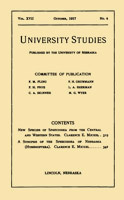University Studies of the University of Nebraska
Date of this Version
1-1949
Citation
1949 by the Board of Regents of the University of Nebraska
Abstract
Emily Dickinson's poetry is now accepted by most students of literature as an American classic. In this brief study, I have tried to show one of the reasons why this has come about. After her first two volumes appeared in 1890 and 1891, many of the reviews were extremely critical. Typical of these is one which appeared in the Atlantic Monthly of January, 1892.
If Miss Dickinson's disjecta membra are poems, then Shakespeare's prolonged imposition should be exposed without further loss of time, and Lord Tennyson ought to be advised of the error of his ways before it is too late. But I do not hold the situation to be so desperate. Miss Dickinson's versicles have a queerness and a quaintness that have stirred a momentary curiosity in emotional bosoms. Oblivion lingers in the immediate neighborhood.1
In spite of the fact that many early critics agreed with this appraisal and many constant readers of poetry still insist that they do not care for her work, Emily's fame has gradually grown until, when her last volume, Bolts of Melody, finally appeared in 1945, it was received with almost universal acclaim by leading contemporary critics and the general reading public. Writing in Poetry, Babette Deutsch summarized this attitude thus:
From the start mystery and miracle have been the fibre of Emily Dickinson's literary life, and time has done little to destroy it.2
These two widely divergent estimates of the poetry of Emily Dickinson, written approximately fifty years apart, indicate the gradual growth of her literary fame as well as the continued controversy over the enduring value of her work. However, even those who do not consider her poetry of first rank must concede that she is no longer to be classed among "forgotten poetesses." 3 One reason for this is the quality of the imagery in her poetry. The fragmentary nature of many of the poems, their irregularity of form, the grammatical aberrations which occur at times, the elaborate conceits and occasional mixed metaphors cannot dispel the unusual power of the imagery, the most salient characteristics of which are vividness, boldness of conception, interplay of the concrete and the abstract, variety of sense appeals, drama, freshness and surprise. On the other hand, the most abstruse and cryptic of her "versicles" and those most likely to be neglected are the ones lacking in imagery. When at last those poems of enduring value have been winnowed from the chaff of the obscure and ephemeral, certainly those rich in imagery will be the ones to survive. This is true, it seems to me, because Emily Dickinson's poetry satisfies man's perennial desire for an enhanced appreciation of the significance of life, death, nature, love, and immortality; and it does so chiefly because of imagery that clarifies the ideas expressed, intensifies the emotions aroused, and through overtones of suggestion releases the imagination from its accustomed bounds. Those of us who value the poems do so because we enjoy leaning with Emily against the sun and glimpsing for a moment with delight, doubt, hope, and a touch of gay irreverence the Paradise she visioned.
CONTENTS: PREFACE / INTRODUCTION / I IMAGERY AND POETRY / II SOURCES OF EMILY DICKINSON'S IMAGERY/ III APPEALS TO THE SENSES / IV IMAGERY OF NATURE / V IMAGERY OF DEATH / VI IMAGERY OF LIFE, LOVE, AND IMMORTALITY / BIBLIOGRAPHY

